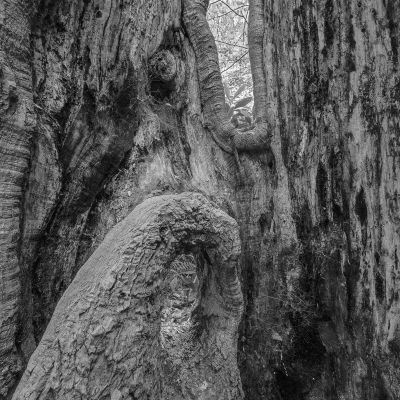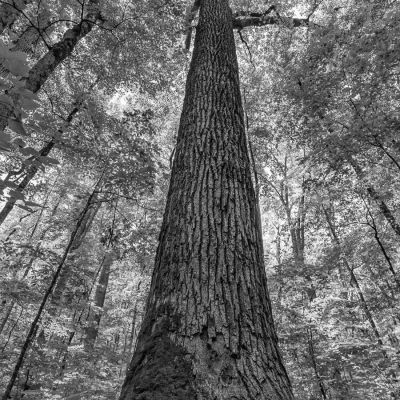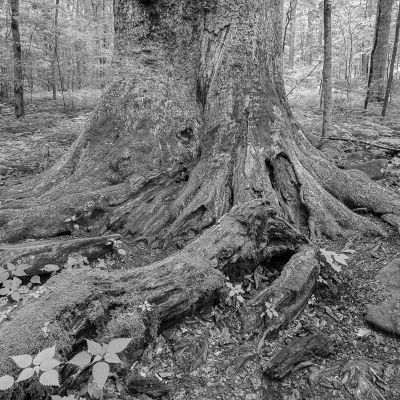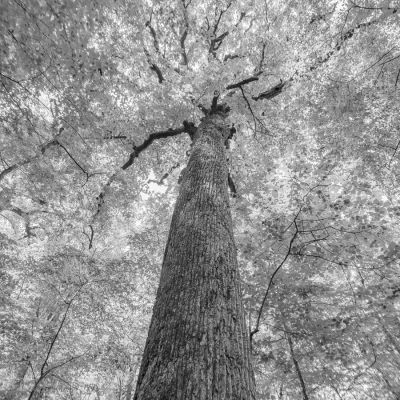Story Info
Story Info

Lynne Buchanan
Joyce Kilmer Memorial Forest
2023
Type of Wounded Place
Story & Experience
This is the third old growth forest in the Southeastern United States that I have visited recently. The first one I went to was the Moody Forest in Georgia and the second was the Albright Grove in Tennessee, which I visited earlier on the day I heard Trebbe Johnson speak for the first time. I had been so heartbroken seeing all the fallen giants in the Albright Grove that I ended up doing more research on old growth forests in the United States. I could tell they had been affected by climate change and blights, and that had made me very sad. When I started reading up on old growth forests, I learned that they are actually more rather than less resilient than younger forests due to their roots and all the nutrients they provide for the soil, even after they have died. When forests are clearcut, the soil is much less healthy. The fungi and biomass is disturbed, the land is more prone to runoff, and trees are more likely to topple and die. Old growth trees sequester a huge amount of carbon, and if they are harvested they will release a lot of carbon back into the atmosphere. Thankfully, modern forestry practices advise leaving the dead trees where they fall. When the fungi breaks them down, they provide nutrients for the forest, as well as sheltered places for creatures to live. Even the day I was in the Albright Grove and was feeling so depressed, I still took note of the wildflowers, ferns, and other biodiversity on the forest floor. In clearcut forests, invasive plants are more likely to overtake native flora and fewer nutrients are provided for the biosphere. The trees become less healthy too. I wanted to offer the Joyce Kilmer Memorial Forest an act of beauty in appreciation for the thriving life that still exists there and in recognition of all this and other old growth forests do for the environment. Old growth forests store the vast majority of carbon on the planet and will continue to do so as long as they are not cut down or burned. However, I should note that there is currently a debate as to whether younger or older trees take up more carbon. Younger trees may take in my carbon, but as they age they will take in less and when they are younger they are more prone to suffering from the effects of climate change and dying. All forests deserve protection, because the trees that are alive now are what are helping offset carbon. It takes decades for reforestation to make an impact. Another reason to protect Joyce Kilmer, the Albright Grove, and the Pisgah forest is that the loss of forest canopy is the greatest in the Southeastern United States than anywhere on the planet, due to the wood pellet and biomass-burning industry. Climate change is having a huge impact on all lifeforms and in the future trees may not live as long as trees have in the past. This should inspire us to be even more conscientious about preserving all our forests. Forests that are not old growth yet, will become old growth forests in the future if they aren’t cut down. Old growth forests have trees that are at least 120 years old, but many existing old growth forests have trees that are 200 to 400 years old. The upper loop of Joyce Kilmer still has examples of trees that are this old.
Here are several articles on this subject that I found of interest:
https://e360.yale.edu/features/why-keeping-mature-forests-intact-is-key-to-the-climate-fight
https://www.uvm.edu/news/story/new-forestry-old-growth
This is the third old growth forest in the Southeastern United States that I have visited recently. The first one I went to was the Moody Forest in Georgia and the second was the Albright Grove in Tennessee, which I visited earlier on the day I heard Trebbe Johnson speak for the first time. I had been so heartbroken seeing all the fallen giants in the Albright Grove that I ended up doing more research on old growth forests in the United States. I could tell they had been affected by climate change and blights, and that had made me very sad. When I started reading up on old growth forests, I learned that they are actually more rather than less resilient than younger forests due to their roots and all the nutrients they provide for the soil, even after they have died. When forests are clearcut, the soil is much less healthy. The fungi and biomass is disturbed, the land is more prone to runoff, and trees are more likely to topple and die. Old growth trees sequester a huge amount of carbon, and if they are harvested they will release a lot of carbon back into the atmosphere. Thankfully, modern forestry practices advise leaving the dead trees where they fall. When the fungi breaks them down, they provide nutrients for the forest, as well as sheltered places for creatures to live. Even the day I was in the Albright Grove and was feeling so depressed, I still took note of the wildflowers, ferns, and other biodiversity on the forest floor. In clearcut forests, invasive plants are more likely to overtake native flora and fewer nutrients are provided for the biosphere. The trees become less healthy too. I wanted to offer the Joyce Kilmer Memorial Forest an act of beauty in appreciation for the thriving life that still exists there and in recognition of all this and other old growth forests do for the environment. Old growth forests store the vast majority of carbon on the planet and will continue to do so as long as they are not cut down or burned. However, I should note that there is currently a debate as to whether younger or older trees take up more carbon. Younger trees may take in my carbon, but as they age they will take in less and when they are younger they are more prone to suffering from the effects of climate change and dying. All forests deserve protection, because the trees that are alive now are what are helping offset carbon. It takes decades for reforestation to make an impact. Another reason to protect Joyce Kilmer, the Albright Grove, and the Pisgah forest is that the loss of forest canopy is the greatest in the Southeastern United States than anywhere on the planet, due to the wood pellet and biomass-burning industry. Climate change is having a huge impact on all lifeforms and in the future trees may not live as long as trees have in the past. This should inspire us to be even more conscientious about preserving all our forests. Forests that are not old growth yet, will become old growth forests in the future if they aren’t cut down. Old growth forests have trees that are at least 120 years old, but many existing old growth forests have trees that are 200 to 400 years old. The upper loop of Joyce Kilmer still has examples of trees that are this old.
Here are several articles on this subject that I found of interest:
https://e360.yale.edu/features/why-keeping-mature-forests-intact-is-key-to-the-climate-fight
https://www.uvm.edu/news/story/new-forestry-old-growth
Why this Place?
Joyce Kilmer Memorial Forest
The Joyce Kilmer Memorial Forest is one of the last old growth forests in the eastern United States. It was set aside as a memorial to Joyce Kilmer, who wrote the poem trees, in 1936. Only one half of one percent of forests in the Southeastern United States are old growth. This forest has suffered two major blights: the chestnut blight in the 1930s. More recently, the hemlock trees died off from the hemlock woolly adelgid. In 2010, the forest service blew up the dead trees with explosives, since they were afraid they would fall on visitors. The lower loop has been completely changed as a result of these blights. Fortunately, the upper loop contains a lot of tulip poplars up to 400 years old that were not affected. I chose this place because of the importance of honoring and preserving old growth forests, because of both their rarity and how they contributed to the environment, even when they appear wounded and harmed. This is the poem Joyce Kilmer wrote, for those who don’t know it (apologies for the spacing on this form):
Trees
I think that I shall never see
A poem as lovely as a tree.
A tree whose hungry mouth is press
Against the earth’s sweet flowing breast;
A tree that looks at God all day
And lifts her leafy arms to pray:
A tree that may in Summer wear
A nest of robins in her hair:
Upon whose bosom snow has lain:
Who intimately lives with rain.
Poems are made by fools like me,
But only God can make a tree.
Act of Beauty
Say more about your actions and activity
I first walked the lower loop of Joyce Kilmer and was not sure what I could create as an act of beauty. As I came close to approaching the upper loop, I found a tree that was missing its trunk on one side and was hollowed out. It even had two holes in the bark that you could see completely through, which the tree had formed protective bands around so that whatever had harmed the tree did not kill it. The amazing thing was that above this very damaged section of the tree, the trunk had managed to generate a new section that looked healthy and supported a vibrant canopy. This tree was an amazing survivor and I knew it had so many lessons to teach all of us. The phloem somehow managed to transport enough water and nutrients to not just continue existing, but to do so much healthier than I would have expected. I decided that this tree was the one I wanted to make several photographs of and that the base of the tree on the side where the trunk had completely disappeared was where I should build a tribute to this forest. I did not however want to harm or kill anything in making my tribute, so I collected some twigs, rocks, and a few leaves that were still green from the forest floor. I built a screen across the open area that I felt was symbolic of protection for this forest, as well as a tribute to the fallen ones. In addition to the offering I made for the tree, I also photographed some other old growth trees and the forest floor.
RECENT STORIES
For the Gulf Coast
Our beaches are being bombarded almost daily since the end of the first week of the sinking of the Deep Water Horizon with gatherings of people or all stripes: protests, prayer groups, volunteers, rallies for [...]
Remembrance Day for Lost Species in Helsinki 2023
On November 30th, there was first a session organized by the Finnish social and health sector project about eco-anxiety and eco-emotions (www.ymparistoahdistus.fi). This “morning coffee roundtable”, a hybrid event, focused this time on ecological grief [...]
Ashdown Forest
Ashdown Forest is an area of natural beauty in West Sussex, England. It is also one of the very few remaining areas of extensive lowland heath left in Europe. This rare and threatened landscape is [...]









